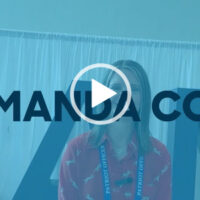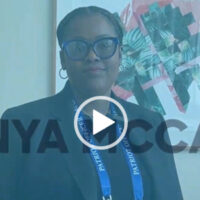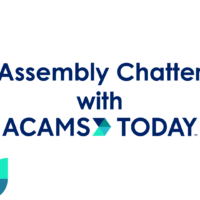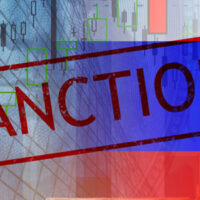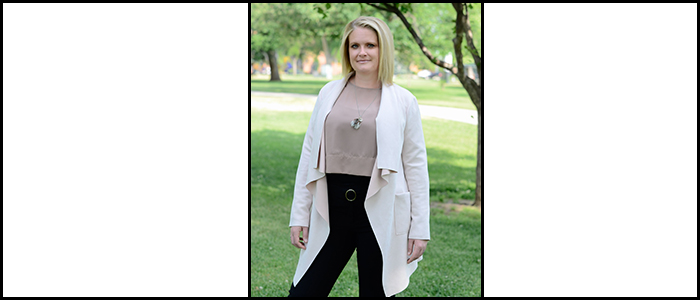
ACAMS Today had the opportunity to sit down and speak with Megan Lundstrom, an anti-human trafficking subject-matter expert and survivor, consultant, co-founder and CEO at The Avery Center (TAC). Lundstrom discussed what led to the formation of TAC, her personal human trafficking (HT) experience and how financial institutions (FIs) and law enforcement (LE) can partner with HT service centers to help identify red flags and assist victims of HT.
AT: It was a pleasure listening to you speak at the ACAMS Hollywood Conference. Your story is inspiring, could you please share your courageous story of how you were able to escape HT?
ML: Yes, I will share my story at a high level. My full story can be found in Elle magazine. I was trafficked as a single mom in my early twenties. It is important for people to understand that exiting the HT life is not like it is portrayed in movies like Taken, which have done us an injustice by thinking that you just kick open a door and carry a trafficked victim to freedom and the trafficked victim then just lives out the rest of their life. The reality is that this scenario happens in very few cases. Exiting HT is a huge process.
My process started the day I entered the trafficking world. It was five years of trying to get out. I was finally able to escape my second trafficker in Las Vegas and relocate back to my family of origin. I stayed with my family for a month until I was able to find my own housing, but I was still trapped in the commercial sex trade at the time. I had a criminal arrest record; I did not have a college education and I was a single mom. All these barriers prevented me from truly exiting the trafficking world. Even though I did not have a third-party controller during the last six months that I was in Las Vegas, by definition, I was still being trafficked as I did not want to engage in prostitution. During those six months that I did not have a third-party controller, I was reconnecting with my family and beginning to access services. I reenrolled in college and started to make connections within the community. On December 1, 2012, I was arrested for the eleventh time. I want to be clear that LE did not help me exit HT, but it was a defining moment for me because I had done all this work for the past six months to get to a place where I realized that I was either going to do jail time after that many arrests and lose my kids or I was going to die. It was not going to get better from there. At the time of my arrest, nor in any of my 10 other arrests, was I at any point ever screened by LE for trafficking or offered services to help me leave the HT world. I like to think that a lot of that has changed. It has been 10 years this year since my last arrest and HT efforts have shifted and LE is doing screenings. Folks that intersect with victims are starting to identify the signs of HT, offer services and make HT reports. A decade ago, there were no services for people like me, but things are changing.
AT: As far as LE, you said things have changed and from my perspective, I would also say things have changed. What are some tips or suggestions or resources that LE could share or give to HT victims?
ML: TAC provides two different types of training that could benefit LE. The first one is cultic theory training. The image that comes to mind when we think of trafficking is usually pimp controlled. Pimp controlled trafficking meets all 15 characteristics of a cultic group. Understanding those social coercion dynamics can help LE understand why victims will defend their traffickers and even identify with the trafficker’s mission. Also, to understand when victims say they are choosing to do this, and they do not want help. Understanding the mind control and grooming that is part of the HT process, will help LE when dealing with victims.
When I think back to my own experiences with LE, most of my arrests happened in Las Vegas and most LE in Las Vegas see most women in prostitution as consenting sex workers that are breaking the law. This is the reason why they do not screen the women or offer them services to escape HT. However, if you start looking at it from the lens of cultic theory, you start to recognize that HT victims have been conditioned to smile and make statements that we are choosing these things. We are also protecting the person that is our provider because they are meeting all our basic needs: food, shelter, clothing and caring for our children. If we turn on them, we will lose our basic needs and for a HT victim, being able to replace all these things with valid accessible things is extremely important.
The second piece that I believe is helpful for LE is a framework that is called the stages of change model. It is during this stage that LE intervention is not as successful as we all hope it would be. Just because—we as professionals—are ready, able, and willing to provide assistance, it does not mean we are meeting someone who is in a place that is ready or able to comprehend what is going on and recognize that they need help and will be willing to access the assistance provided. The stages of the model assess where a person is in their own journey and their own awareness of their situation. The model meets the person at the stage they are currently in, and it equips the individual with information they can use at that time.
TAC’s partnership with LE is extremely important, especially when we are participating in undercover operations. The LE officer looks at the situation and the trafficker from the legal perspective, while TAC provides support services to the HT victim. One thing of importance from this partnership is that both AC and LE are in the same room and having the same conversations with the HT victim. The partnership also lets the HT victim know that they have the support and resources they need from TAC and the victim also knows that these services are not dependent (at least in the U.S.) on if they cooperate with LE. Cooperating with LE does open a whole lot of other services, but someone who is being exploited can also directly connect with a service provider and they do not have to testify if it is too risky for them.
The stages of the change model are important because normally, when we intervene in a situation, the person is usually in the contemplative stage, which means they are in the mindset of “I do not need help. Leave me alone.” I would add that more education on this issue or stage is what LE needs and also partnering with survivor-led organizations.
AT: A follow up to your comment about LE partnering with survival-led organizations, would you say TAC is an example of one of those centers?
ML: Yes, absolutely! We have an entire services department. We have care packages for HT victims, a financial wellness curriculum, job and housing program, peer-support groups, individual therapy and more. All these services are accessible to HT victims without an LE referral. They can contact the TAC directly.
AT: Could you tell us more about TAC and what led to its formation? Also, how can the anti-financial crime (AFC) community support or partner with the center?
ML: TAC is based in my hometown. The rural community of Greely, Colorado. Greely is a small community with not as many resources for HT victims as opposed to New York, Los Angeles or Chicago. Also, at the time I exited HT, I was labeled as a criminal because I had been arrested and society does not offer resources to criminals, but there are crime victim resources. This made it difficult for me and it also reinforced what my traffickers had been saying to me, that I was making these choices for myself and at the same time, my family was telling me I was making bad choices. And to not qualify for any services because I was not a crime victim made it even harder for me. I started to think, “I really did make these bad choices on my own” and that “I am a bad person and mom.” This was a difficult time. I started to go back to school, but in my mind, I felt that I did not just make these choices, there was more to my story. It was a sequence of events leading up to the moment where I became a trafficked victim, and I did not have control of that moment. I discovered I did not have the language to express what had happened to me. As I started learning more about HT, exploitation and the intersection of domestic violence, it started to make sense and I had the language to describe my experience. At this point, I realized that my community was ground zero for the oil and gas boom (around the year 2015). I had been trafficked in the oil fields of North Dakota and I was seeing the same thing I saw in North Dakota happening to my hometown.
AT: Were you in Greenly when you were trafficked to North Dakota?
ML: No, I met my first trafficker in Denver and then I was sold to a trafficker in Las Vegas. While I was in Las Vegas, I was flying up to North Dakota every couple of weeks.
AT: This leads us back to the question of the formation of TAC and how the community can support or partner with the center?
ML: I realized that my hometown was not prepared for the underbelly of what the oil and gas boom would bring. Everyone was focused on the economic prosperity. With prosperity come people with money and new operations form, but not all the operations have good or legal motives. This is when I realized I needed to heal by speaking my own truth publicly. As I did not want what I saw happen in North Dakota to happen in my hometown. I started speaking publicly and I saw quite of few organizations who had victims who were seeking services, but these organizations were not identifying these victims as HT victims. For example, a pregnant woman would present herself to a pregnancy resource center for assistance, but the center would not screen her for HT. HT screening was also not occurring in homeless shelters and domestic violence centers. As a result of me sharing my story, several centers started reaching out to me and wanted to send HT survivors my way. I, at the time, did not have any services or a center where I could aid HT survivors. This experience made me realize that there were gaps in our community, and this is what led me to start TAC for HT survivors. One of those gaps was not offering HT survivors living-wage-felon friendly employment. One of the first services offered by TAC was a job training program for HT survivors.
AT: Are there any other services that TAC provides that you would like to share with the readership?
ML: Yes, there is a care package program that goes to 100 survivors and currently exploited victims on a monthly basis. Presently, the care package program has a waitlist. The care package program is a fantastic way for companies to get involved in helping HT victims. Another way for companies to help is through our workforce readiness program and apprenticeship. We like to build partnerships with companies that are willing to hire survivors into positions that match the survivor’s skillsets and career goals. Companies can be involved by sponsoring a survivor to go through TAC job program and/or be one of the hiring partners for our program graduates. Another option is through our housing program, which is federally funded, but we would like to expand it nationally.
We also have the financial wellness curriculum, which is our survivor’s guide to money. I developed this program as my undergraduate degree is in finance. This curriculum is a workbook or can be completed as an e-course. FIs could help by sponsoring survivors to go through the financial wellness program. The program is focused on addressing the financial abuse trauma experienced by victims. Financial abuse trauma is a big piece of a survivor’s wellness, and it can impact survivors’ ability to economically stabilize after leaving the HT world. Finally, we have peer support and therapy programs. Both programs are federally funded.
AT: What effect did COVID have on HT?
ML: We did quite a bit of research on this. We currently have several reports on TAC website, but I would like to highlight a few findings. One of our initial findings in the survey—when comparing survivors and non-survivors—is that privilege was a big factor in how survivors were thriving or not thriving during the pandemic. For example, most HT survivors are considered nonprivileged. HT survivors were losing their jobs and had to socially isolate because they were more likely to have chronic illnesses due to the intense trauma experienced by their bodies. Being isolated and trapped in their homes was extremely triggering for survivors. Some of the HT survivors might have been exited from HT but were trapped in a home with an abuser. These are some of the challenges HT survivors faced during the pandemic.
Another thing we saw during the pandemic was the explosion of OnlyFans. I have done a lot of work with Polaris and their financial intelligence units working group around the topic of social media. In one of the studies, we focused on trafficking victims travel patterns through social media. We started mapping locations where victims were checking in and we were able to inform FIs how travel patterns of HT victims have changed. One of our findings showed that the victims who were controlled by a third party tended to stay in either their city or state of residence, whereas victims who did not have any indicator of a third-party controller continued to travel. This was surprising as I was expecting the opposite to occur. Another interesting finding is that we saw a lot of trafficking victims reconnect with their families. Their traffickers would send them to their families because they could not afford to house the HT victims. This provided an exit opportunity for quite a few HT victims. Some were able to go back to school, start their own small business and pursue other sources of income.
AT: How has social media changed the process of grooming and recruiting victims of HT?
ML: Back to the topic of OnlyFans, a lot of the sexual exploitation has moved online. It is has become more difficult for LE to investigate because selling pictures and videos is not illegal in and of itself. In order for LE to investigate, there has to be a report or self-disclosure.
A lot of my trafficking was reinforced through social media. I still have this massive network of victims that are still being trafficked and are part of that social media community. Traffickers control your social media, and you are only allowed to follow certain accounts and like certain posts. This creates a social media reality bubble and that becomes your reality, which reinforces what is happening in your real life.
On the flip side, some traffickers do not allow their victims to use social media because it is a double-edged sword. The victims might be discovered; however, some traffickers encourage their victims to use social media. Some traffickers will require their victims to give them their passwords and the traffickers will pretend to be the victim and use the victim’s social media account to recruit others. Other traffickers will coerce their victims to do the recruiting. Recruiting on social media is very common and making HT a glamourous space and normalizing it is one of the goals. Also, as a victim, you are required to glamorize your lifestyle on social media, or you may face punishment by your pimp.
AT: What red flags or indicators should AFC professionals or LE look for in social media accounts?
ML: Polaris and I are working on a social media identification manual for FIs. Social media was part of my exploitation and I have been part of the HT social media community for 12 years, this is a big piece, and it is open-source intelligence. There are many traffickers that build their own case on social media and once you start to see it, you cannot unsee it. For example, there are hashtags, emojis, photos, indicators, etc. In fact, I have a picture of a girl who is doing the sign language symbol of a “p” that within the context of the picture stands for pimp. When you see this type of symbol on social media, it means that the person is identifying as a pimp or is under the control of a pimp. Another thing you see is that pimps will require their victims on social media to have some variation of the pimp’s handle in the victims’ handles. This is a form of branding. Victims are branded by the handle they are supposed to use, the hashtags and emoji sequences. A lot of these types of branding will also appear in financial transactions, particularly in peer-to-peer platforms. An example we are seeing is traffickers—as part of their psychological abuse of victims—will block the victims' phone numbers and social media accounts. This is a type of social punishment, and it is done by pimps to socially isolate victims to activate the victim’s trauma bond with them. This is effective because the trafficker is getting the psychological response and money from the victim. The victim will send money through a Cash App, but in the memo line they will send messages. So, you will see message, message, message and each one is a dollar to two dollars per transaction, but it is an entire conversation from the victim to the trafficker. This is a new HT trend. There is so much that can be done to stop HT, but it is valuable to have survivors provide the input they have had through their experiences by sharing screenshots of conversations they have with their pimps and all their bank transactions with the pimp. There will be more information about this in the resource guide we are working on with Polaris.
AT: During our interview and at the ACAMS Hollywood Conference, you mentioned there are three types of pimps, could you describe red flags for identifying financial transactions made by pimps or HT victims?
ML: The first two types of pimps I described earlier were the boyfriend pimp and the CEO pimp. My personal experience was with these two types of pimps. I would like to add that the research I did on my financial transactions is the first time this type of research has been done directly from a HT survivor. My experiences are valid, and I can see what happened to me, but as they are solely my experiences, they may not be broadly applicable from a research perspective to all trafficking victims. This is an opportunity for FIs to work with survivors to analyze the survivors’ bank statements to help identify this type of activity within their FIs. I would love to see FIs hire survivors for these types of research projects because together I believe we can stop various HT financial crimes.
All forms of pimps intersect with gang-controlled trafficking. This includes boyfriend and CEO pimps, but gorilla pimps strongly intersect with gang-controlled trafficking. Gorilla pimps use forced kidnapping, drug abuse and brutal physical abuse. It is shorter in duration, but it is horrifically violent for the victim.
AT: Any tips for LE and front-line AFC professionals on how to spot key indicators such as tattoos or lingo that could identify a victim of HT? Also, do financial transactions change depending on the type of trafficking?
ML: Things are constantly changing. One of the things that are changing is tattoos. Traffickers are moving away from tattoos because they are a known indicator. Another thing we see on indicator lists are multiple phones, but now things are changing because there are so many apps. Communication is done on one phone, and it is not necessary to have multiple phones. Some of the red flags we are focusing on now will eventually become obsolete as technology changes and awareness increases. When we think of typologies for traffickers, there are different indicators for different types of trafficking. One of the things I noticed when I analyzed my own financial statements while I was being trafficked by a boyfriend pimp is that my financial transactions mimicked that of a normal person receiving a paycheck at the end of the week. For example, I would pay my bills and get groceries with the money I was receiving. My financial transactions looked standard. Some of the red flags were that I was depositing cash every week and that there was no paycheck. Second, I always had payments for Backpage (it was still up when I was being trafficked) and escort website payments. However, with a CEO pimp, I had to take my utility bill to my pimp, and he would give me the exact amount I needed to pay my bill. I would take that money to the bank, deposit it and then pay my utility bill. Different traffickers manage the money differently so red flags will also look different. One of the things that was apparent on all of my financial transactions is that I appeared to be a customer who was in financial distress. For example, I had thousands of dollars of overdraft fees and at the end of every month I was overdrawn by a couple of dollars. At first, this could appear as someone who was living paycheck to paycheck, but when you start to add in all the other indicators, you start to see there is more to it.
AT: Which communities are most vulnerable to HT and how can FIs identify these communities and use data to mitigate risk?
ML: The most marginalized in society are the ones that are preyed upon by traffickers because the marginalized either do not have other choices or traffickers can promise to meet the victim's needs in ways that systems, institutions, and communities are not able to.
Immigrants and undocumented individuals are high risk and when it comes to FI there are barriers for this group when trying to access the financial system. Other segments of the population that are preyed upon are anyone from the LGBTQ community, people of color or anyone who faces systemic oppression or marginalization is at higher risk for HT.
When it comes to FIs, it is having those bigger conversations and looking deeply to see where those systems are creating barriers for people. How do we fix it and make things more accessible—because economic stability is everything.
AT: One of the many reasons why HT exists is due to the high demand, what steps can we take as a society to curtail the demand of HT?
ML: When we think of labor trafficking, we are all somewhat complicit. Do you know where your clothes came from? My suggestion is to pick something and be dedicated to that. For example, you can choose to do a better job of knowing where your clothes come from. If that is what you choose, then make sure you do a good job of bringing awareness, learning and educating others on the things you have learned.
Sex trafficking is also fueled by demand. Worldwide, the U.S. is the largest consumer of commercial sex. When you look at who is fueling the sex trafficking industry, it is usually affluent men in positions of power and influence; however, these men can also be part of the solution. Also, people who have influence, power and disposable income can be part of the solution and not the problem. What is the most powerful thing they can do? It is not to buy or consume sex. If we reduce the demand, it is no longer profitable for traffickers. Another important part is to have conversations with the younger generation that other people’s bodies are not there for them to access and use at their convenience.
AT: Are there any resources in combating HT that are not readily available but should be?
ML: In speaking to other centers, we hear a common theme that they are scared to advertise their services too loudly because they are unable to cover the plethora of requests they receive. In other words, they are unable to meet the needs of so many. To find a solution to HT crime, we all need to be proactive to reduce demand and organizations that are providing the services needed by HT victims need more funding to meet the needs of the victims.
AT: Do you have a mantra by which you live by that you would like to share with the ACAMS’ readership?
ML: One of my favorite quotes is by Marianne Williamson. She said: “Our deepest fear is not that we are inadequate. Our deepest fear is that we are powerful beyond measure. It is our light, not our darkness that most frightens us. We ask ourselves, 'Who am I to be brilliant, gorgeous, talented, fabulous?' Actually, who are you not to be? You are a child of God. Your playing small does not serve the world. There is nothing enlightened about shrinking so that other people won't feel insecure around you. We are all meant to shine, as children do. We were born to make manifest the glory of God that is within us. It's not just in some of us; it's in everyone. And as we let our own light shine, we unconsciously give other people permission to do the same. As we are liberated from our own fear, our presence automatically liberates others.”
*Visit The Avery Center for more information on how you can contribute to their mission.
Interviewed by: Karla Monterrosa-Yancey, CAMS, editor-in-chief, ACAMS, editor@acams.org







